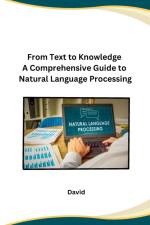av David
369,-
Natural Language Processing (NLP) is a rapidly evolving field that has gained significant attention in recent years. It has revolutionized the way we interact with machines and has become an integral part of many applications we use daily, such as virtual assistants, chatbots, and language translation tools. This subchapter aims to provide a comprehensive overview of the history and evolution of NLP, from its humble beginnings to the advancements that have shaped it into what it is today.The roots of NLP can be traced back to the 1950s, when researchers began exploring the possibilities of machine translation. The initial attempts were rule-based, relying on manually crafted linguistic rules, but they were limited in their ability to handle the complexity of language. In the 1960s, statistical approaches emerged, using probability models to determine the likelihood of word sequences. However, these methods also faced challenges due to the lack of computational power and data availability.The 1980s marked a turning point with the introduction of machine learning techniques. Researchers started using large corpora of text to train models, which led to significant improvements in language processing tasks such as part-of-speech tagging and syntactic parsing. However, these models were still limited in their ability to understand the nuances of language and context.The late 1990s and early 2000s saw the rise of statistical machine translation, driven by advancements in machine learning and the availability of vast amounts of parallel corpora. This approach, based on aligning sentences in different languages, paved the way for modern language translation systems.The advent of deep learning in the 2010s revolutionized NLP. Deep neural networks, such as recurrent neural networks (RNNs) and transformers, brought breakthroughs in tasks like sentiment analysis, named entity recognition, and question-answering systems. The ability to process language at a more semantic level and capture contextual dependencies has led to significant improvements in NLP performance.With the increasing availability of large-scale datasets, the emergence of pre-trained language models like BERT, GPT, and Transformer-XL has further pushed the boundaries of NLP. These models, trained on vast amounts of data, have achieved state-of-the-art results on various tasks and enabled transfer learning, allowing models to be fine-tuned for specific applications with smaller datasets.As NLP continues to evolve, new challenges and opportunities arise. The integration of NLP with other domains, such as computer vision and knowledge graphs, has the potential to unlock even more powerful applications. The field is also exploring ways to address biases in language models and improve their interpretability.



















![Great War [microform] af David](https://cdnbackdoor.tales.as/thumbnail/150x225/products/00134/59670/great-war-microform-speech-delivered-by-the-rt-hon-david-lloyd-george-mp-chancellor-of-the-exchequer-at-the-queens-hall-london-on-septembe.jpg)
![Trial of David M'Lane for High Treason [microform] af David](https://cdnbackdoor.tales.as/thumbnail/150x225/products/00134/54854/trial-of-david-mlane-for-high-treason-microform-before-a-special-court-of-oyer-and-terminer-at-quebec-on-the-7th-july-1797.jpg)



![Narrative of Colonel David Fanning (a Tory in the Revolutionary War With Great Britain) [microform] af David](https://cdnbackdoor.tales.as/thumbnail/150x225/products/00134/48894/narrative-of-colonel-david-fanning-a-tory-in-the-revolutionary-war-with-great-britain-microform-giving-an-account-of-his-adventures-in-north-carol.jpg)


![Constitution and Order of the London Ecclesia of Immersed Believers of the Things of the Kingdom of God and the Name of Jesus the Christ [microform] af David](https://cdnbackdoor.tales.as/thumbnail/150x225/products/00134/47082/constitution-and-order-of-the-london-ecclesia-of-immersed-believers-of-the-things-of-the-kingdom-of-god-and-the-name-of-jesus-the-christ-microform-e.jpg)

